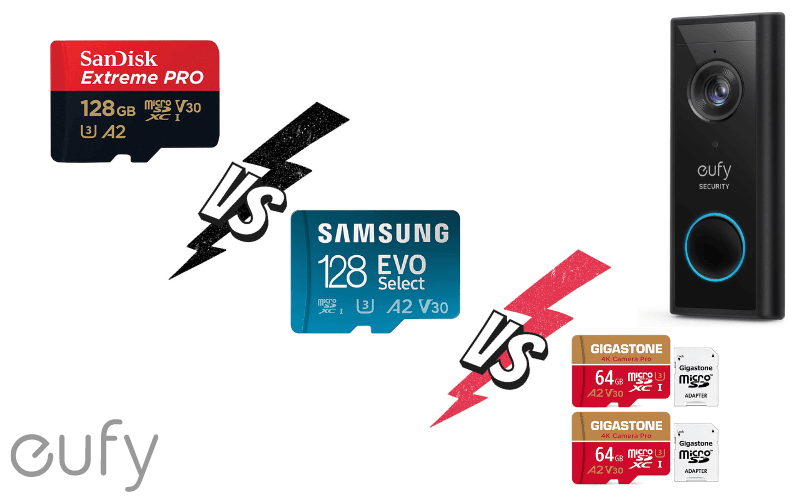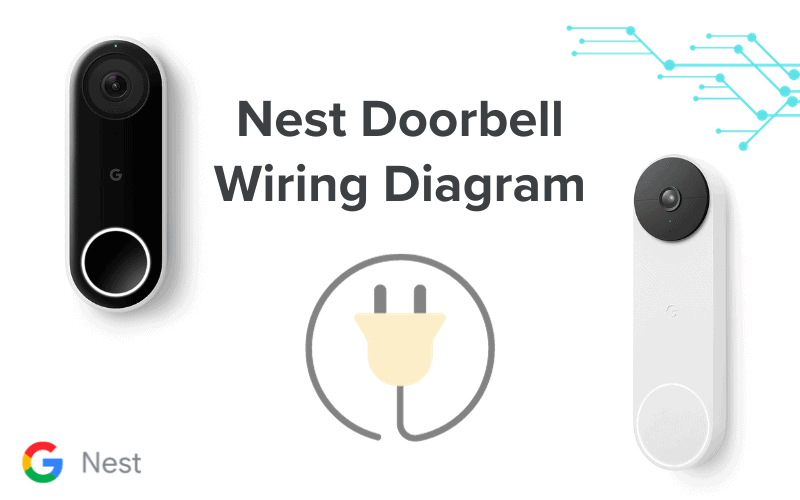If you are looking to purchase a Nest Doorbell, there are two options to choose from:
- the “original”, 1st Gen Nest Doorbell,
- or the upgraded 2nd Gen Doorbells.
Both devices, while quite similar, have their fair share of differences. Before choosing one to commit to, a proper comparative review of both would do you some good.
This article compared both generations of the Nest Doorbell to help you make an educated choice.
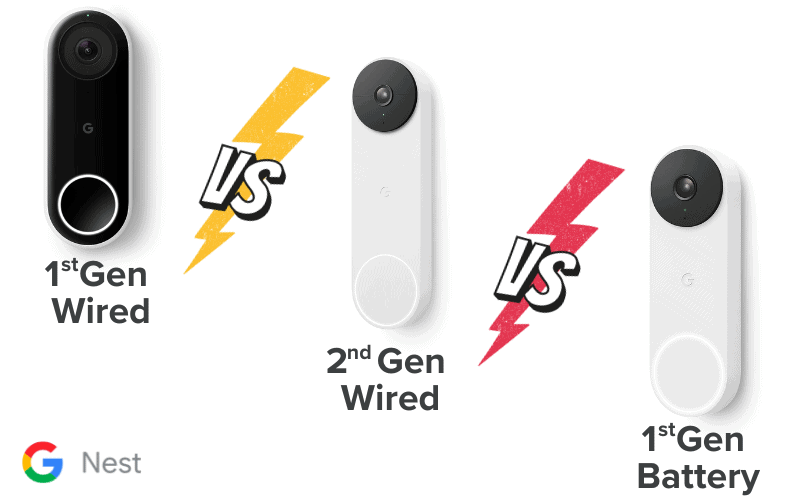
Overview
Nest introduced its first-gen doorbell in February 2018 with many premium features. The doorbell had a camera that offered a wide 160° field of vision and shot HD videos, supported night mode recording, and offered two-way audio.
Building on the initial concept and considering recent trends in the smart home industry, Google launched the 2nd Generation of Nest Doorbells in 2022.
This upgraded model of the classic Nest Doorbells would have many of the old features we’ve come to love about the first-generation doorbells while featuring some new ones.
Before We Get into the Review
Nest devices typically come in two types:
- A wired model
- And a battery-powered model.
The 2nd Gen of Nest Doorbells is one of the few exceptions in this case, as it only has a wired model (at least for now).
1st Gen Doorbells, on the other hand, have both a wired and a battery option.
However, the differences between the 1st Gen wired doorbells and the 1st Gen battery-powered doorbells alternative are significant.
When going through this article, especially when reviewing the differences between both generations, we would be making distinctions between the wired and battery models of the 1st Gen devices.
It is essential to consider these differences as well when making your decision as well.
That being said, let’s get right into the review.
Key Similarities
The 2nd Generation of Nest Doorbells bears many similarities to its predecessor. Below are a few things the two generations of doorbells have in common:
Design
In terms of physical appearance, both generations of doorbells are incredibly similar. There is more of a difference between the 1st Gen Doorbell (battery) and 1st Gen Doorbell (wired) than between the 1st and 2nd Generation of doorbells.
The two generations feature similar design language and could pass for one another.
Both feature a sleek, minimalist, aesthetically pleasing appearance and look good on any modern home.
Both generations have also been designed for outdoor use, so they can all withstand the elements and perform even under harsh weather conditions.
Advanced Motion Detection
Motion detection on Nest devices is advanced, and Nest Doorbells are no exception to this rule.
Unlike many other devices that offer essential motion detection, Nest Doorbells offer a feature called people detection.
The people detection feature uses advanced machine learning for better identification, allowing Nest devices to easily differentiate between people and objects that might move in front of your camera, such as speeding cars.
Nest Doorbells can provide better alerts and avoid false triggers with this feature. Both generations of Nest Doorbells offer this feature.
Audio and Video Support
Both generations of Nest Doorbells support similar audio and video coverage. They both allow you to record audio in HD quality and support two-way audio.
Night Vision
The 1st and 2nd Gen doorbells feature infrared sensors, allowing great night mode recording.
Key Differences
Despite the similarities between both generations, there are significant differences between them. Not only that, though, there are also substantial differences between the two models of the 1st Gen Doorbells available.
A proper comparison of both generations of Nest Doorbells would involve comparing both models of the 1st Gen Doorbells with one another and then with the 2nd Gen Doorbells.
This section will attempt to do this to the best of our capability.
Below are the most notable differences between both models of the 1st Gen Nest Doorbells and their 2nd Gen successor:
Design
Design is one of the notable differences between the Nest Doorbells. Ironically, this is not because of a significant difference between the design of the 1st and 2nd Generation but between the wired and battery-powered models of the 1st Gen doorbells.
The 1st Gen Nest Doorbells wired model features different aesthetics than the battery model.
There are two significant differences in design between the two models of the 1st Gen Doorbells: their color and the logo they bear.
The battery model of the 1st Gen doorbells comes in 4 color options: Snow, Ash, Linen, and Ivy. The wired model, on the other hand, comes in just the Nest Black option.
As for the logo they bear, the battery model features Google’s “G”, while the wired model features the Nest logo.
There is also the dimension of both devices. Where the wired model is practically an all-around smaller device, the battery model is taller, more comprehensive, and heavier while still looking sleeker.
Compared to the design of both devices, the 2nd Gen Nest Doorbells look similar to the 1st Gen Doorbells’ battery model. They feature the same color options, bear the Google logo, and practically share the exact dimensions.
Honestly, both devices are so similar. The 1st Gen (battery) looks more like it should have been branded 2nd Gen (battery) instead.
Video Resolution
Video resolution is another part where the 1st Gen battery is more similar to the 2nd Gen (wired) than the 1st Gen (wired).
Where the wired model of the 1st Generation of Nest Doorbells comes with a 1200p resolution, both the 2nd Gen Doorbells and the battery model of 1st Gen Doorbells feature a lower 960p resolution.
This reduced resolution doesn’t necessarily mean that the 2nd Gen (or the battery model of the 1st Gen) doorbells shoot worse videos than the 1st Gen wired model.
Since the 1st Gen (wired) and the 2nd Gen doorbells have a narrower (though taller) field of view than the 1st Gen doorbells, the reduction in resolution is reasonably justified.
Field of View
As stated earlier, 1st generation Nest Doorbells (wired) have a wider field of view than the battery and 2nd Gen Doorbells.
Unlike their counterparts, which feature a 145° field of view and a 3:4 aspect ratio, the 1st Gen wired has a 160° field of view and a wider 4:3 aspect ratio.
The wider coverage area means your doorbell has significantly reduced blindspots and can afford you a better view of whatever activity or event is being recorded by the doorbell.
That being said, while the 2nd Gen Nest Doorbells (and 1st Gen wired Nest Doorbells) offer a narrower field of view, these devices provide a taller view that lets you see to the foot of the door and allows a head-to-toe recording of anyone at your door.
This taller view allows for much better package detection and identifying smaller creatures like raccoons, which might stray to your doorstep and trigger an alert.
The 1st Gen (wired) model doesn’t just have a wider field of vision. It also has better zoom, capable of up to 8x digital zoom, while the other two can only manage up to 6x zoom.
Intelligent Alerting & Activity Zone
Regarding alerts, the 2nd Gen Nest doorbells outperform their predecessors significantly.
Typically, 1st Gen Nest Doorbells come with just the essential person detection, which uses the camera to alert you when there’s anyone at the door. Package alert, a Nest feature that notifies you when a package is at your door, is only available on this device when you have a Nest Aware subscription.
This device is unavailable for more advanced features like animal and vehicle detection.
The 2nd Generation Nest Doorbells don’t have this issue at all. Not only do they have vehicle and animal detection features that alert you, especially when animals or vehicles are spotted at your door, but you also do not need a subscription to access them. You also don’t need a subscription to get package alerts.
Another feature 2nd Gen Nest Doorbells have over their 1st Gen counterparts is Activity Zone. This feature lets your Nest camera or doorbell monitor certain predetermined positions in the device’s line of sight and alert you of any real-time movement within that zone.
2nd Gen Doorbells feature Activity Zones, while 1st Gen Doorbells do not.
Events History
Both generations of Nest Doorbells offer some event history feature or the other.
Nest offers two types of event history:
- Video event history
- and event snapshot history.
Video event history records clips of any event caught on camera by your doorbell and saves them for some time. On the other hand, Snapshot History takes only images of the event and saves those for a while.
1st Gen Nest doorbells offer different event history options depending on the type of 1st Gen Doorbell you get.
If you are using the wired doorbell, you get three hours of event snapshots. Using the battery model gives you three hours of event video history.
For the 2nd Gen Doorbells, however, both the wired and battery models get three hours of event video history.
The clips or images saved in your history are only accessible for three hours after the recording has been made and disappear after the time limit.
You can view your event history via the dedicated app your device connects to. (See Apps to determine which app each model is compatible with).
Hardware and Software
One significant difference between the two devices that often goes unnoticed is the difference in their hardware.
With the 2nd Gen doorbell being an upgrade, it is a no-brainer to have the best hardware of the three devices. Featuring 10 850 nm infrared LEDs with IR cut filter for night vision rather than the 4 and 8 on the 1st Gen (battery) and 1st Gen (wired), respectively, the 2nd Gen doorbell has the better night mode.
The 2nd Gen doorbell also features software upgrades, including better and faster image processing, better motion and sound detection, and more features without a subscription.
Apps
Again, the difference in App compatibility here is more a difference between the 1st Gen (wired) doorbell and the other two doorbells rather than a 1st Gen vs. 2nd Gen thing.
Where the 1st Gen wired doorbell works with the Nest App, the 2nd Gen, and the 1st Gen (battery) doorbells are only compatible with the Google Home App.
Installation
How you install your Nest Doorbell would be determined more by whether or not the doorbell is wired or battery-powered rather than the generation the doorbell belongs to.
Installing and setting up your Nest Doorbell is relatively easy, provided you know what to do.
When installing your Nest Doorbell, connect your device to the app.
Download the app compatible with your chosen doorbell:
- The Google Home app for 1st Gen (battery) and 2nd Gen (wired),
- and the Nest app for 1st Gen (wired), and then select “Add New Device” to add your new doorbell.
Scan the QR code on the back of your doorbell with your phone to add the device.
Once you have added your device to the app, it’s time to install it.
To install your battery-powered 1st Gen Doorbell;
- Start by fully charging the doorbell. Use the USB cable provided to charge the device till the LED indicator indicates it is fully charged.
- Pick a location to install the device.
- Mount the base plate at the desired location using the provided screws.
- Attach your doorbell to the base plate.
Installing a wired Nest doorbell is a little more complicated. Depending on your precious doorbell set-up, whether or not you have a transformer, and if your transformer and waiting conditions meet the device’s requirements, how you’d install the device would vary.
We recommend that you contact a Nest Pro to help install your device.
Our Take: Nest Doorbell Gen 1 vs Gen 2
There can’t be a Nest Doorbell Gen 1 vs. Gen 2 comparison here.
With the wired and battery models of the 1st Gen Doorbells being so vastly different, a better comparison would be Nest Doorbell Gen 1 (wired) vs. Gen 1 (battery) vs. Gen 2.
When putting the three devices up against one another, the 2nd Gen doorbell outperforms the rest. Being an upgraded version of the 1st Gen doorbells, the 2nd Gen wired doorbell’s improved hardware makes it the better device.
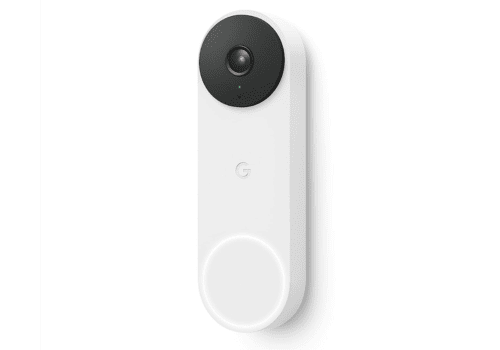
The other two devices also have their appeal.
The 1st Gen (battery) model is an excellent choice for monitoring locations distant from a source of electricity. Their battery-powered nature also means they are unaffected by electrical surges and would remain fully functional in a blackout.
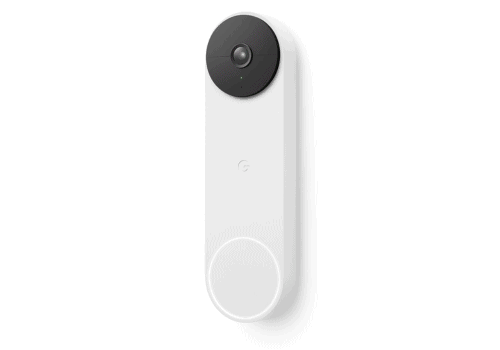
On the other hand, the 1st Gen (wired) model would be a great choice if you have a more comprehensive entrance you’d like to cover. The model’s better zoom capacity is something to look out for if that interests you.
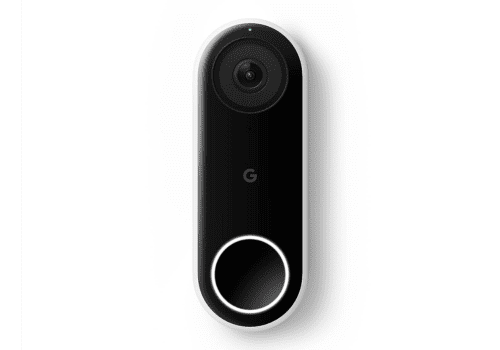
Source
- Technical specs for Nest cameras and doorbells, Google Nest Help
